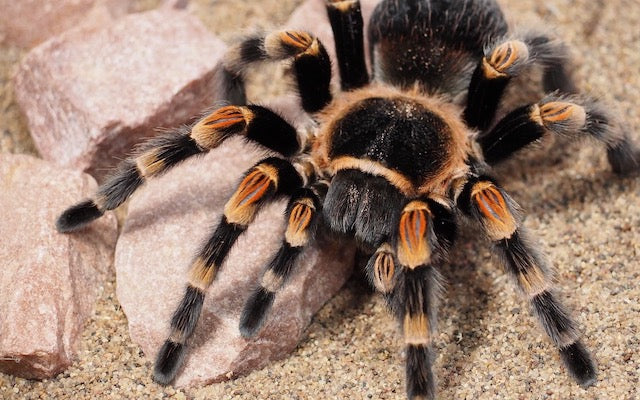If you’re just getting into the tarantula hobby, you’re probably wondering: How long do tarantulas live? A tarantula’s lifespan in captivity depends on many factors—enclosure size, humidity, feeder insects, and other husbandry techniques. But the most important factors in determining your tarantula’s lifespan are its species and its gender.
Depending on species and gender, your tarantula’s lifespan can range anywhere from 3 to 30+ years. Males live shorter lives than females, averaging about 3 to 4 years. Females, on the other hand, average between 10 and 20 years, with some species living over 30 years!
The following chart gives you a breakdown of some of the most popular tarantula species in the hobby, how big they get on average, and around how many years they typically live.
Tarantula Lifespan Chart
|
Species |
Place of Origin |
Average Size |
Female Lifespan |
Male Lifespan |
|---|---|---|---|---|
|
Honduran Curly Hair |
Costa Rica |
6-7 in. |
22-25 years |
4-5 years |
|
Martinique Pink Toe |
Caribbean |
5-6 in. |
11-12 years |
2-3 years |
|
Goliath Pink Toe |
Brazil |
7-8 in. |
10-12 years |
3-4 years |
|
Brazilian Jewel (Dwarf)* |
Brazil |
1-1.5 in. |
Unknown |
Unknown |
|
Chilean Rose |
Northern Chile |
6-6.5 in. |
20-25 years |
4-5 years |
|
Pink Zebra Beauty |
Brazil, Paraguay |
4-5 in. |
16-20 years |
5-6 years |
|
Green Bottle Blue |
Brazil, Paraguay |
5-6 in. |
12-14 years |
4 years |
|
Mexican Red Knee |
Mexico |
6-6.3 in. |
25-30 years |
2-5 years |
|
Mexican Flame Knee |
Central America, Mexico |
5.5-6 in. |
20-25 years |
4-6 years |
|
Brazilian Black |
Brazil |
6-7 in. |
20+ years |
3-4 years |
|
Cobalt Blue |
Burma, Myanmar, Thailand |
5-5.5 in. |
10-12 years |
3-4 years |
|
Texas Brown Tarantula |
Southern United States |
4-5 in. |
30+ years |
7-10 years |
|
Arizona Blond |
Southwest United States |
5-6 in. |
25+ years |
10-14 years |
|
Brazilian Red & White |
Brazil, Paraguay |
6-7 in. |
12-15 years |
3-4 years |
|
Brazilian White Knee |
Brazil |
7-8 in. |
18-20 years |
3-4 years |
|
Chaco Golden Knee |
Paraguay |
6-7 in. |
15-20 years |
3-4 years |
|
Mexican Fire Leg |
Mexico |
5.5-6 in. |
18-22 years |
6-8 years |
|
Gooty Sapphire Ornamental |
Southeast India |
5.5-6 in. |
12-15 years |
3-4 years |
|
Pumpkin Patch |
Colombia |
3.5-4 in. |
8-10 years |
3-4 years |
|
Philippine Tangerine |
Philippines |
5.5-6 in. |
11-12 years |
2-4 years |
*The Brazilian Jewel is a new species to the hobby. They are difficult to find and quite expensive (one sling can cost upwards of $500). They haven’t been in the hobby long enough to observe their lifespan.
Maximizing Your Tarantula’s Lifespan
When compared with other exotic pets – like Bearded Dragons, Leopard Geckos, or Chameleons – tarantulas are a fairly easy pet to keep. Most species only eat a few times per week. There’s little to no enclosure maintenance required. And humidity and temperature requirements are pretty easy to maintain.
That being said, there are a few little things you can do to maximize your tarantula’s lifespan and get the most enjoyment out of being a T-keeper.
-
Proper enclosure size and orientation. Tarantulas need an enclosure that’s 4x their overall size. Terrestrial tarantulas need a horizontally oriented enclosure. Arboreal and fossorial tarantulas need a vertically oriented enclosure.
-
Proper temperature and humidity. Since tarantulas are endemic to countries along the coffee belt, they have fairly similar heat and humidity requirements. That being said, some species are more sensitive to fluctuations in heat and humidity than others. Know the requirements of your particular tarantula species while you’re setting up its enclosure.
- Proper feeding. In the wild, tarantulas are opportunistic feeders. This is not the case in captivity. Tarantulas in captivity are insectivores, and you should offer yours a variety of insects, including crickets and Dubia roaches. Check out the article “What Do Pet Tarantulas Eat” to learn more.
Nail these three things, and your T is in for a long and healthy life.
Takeaway: Your tarantula’s lifespan depends on many factors. However, the most important factors that influence your tarantula’s lifespan are your tarantula’s species and gender. When choosing your first (or 50th) T, be sure you know ahead of time the average lifespan of the species you’re interested in, that way you know exactly what to expect.








